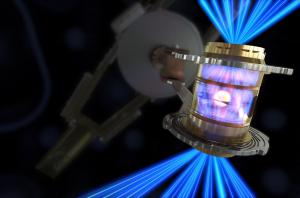ITER applauds NIF fusion breakthrough
ITER scientists hailed the latest experimental results at the National Ignition Facility (NIF) at Lawrence Livermore National Laboratory in California: the achievement of "breakeven" fusion energy. "When future generations look back on the evolution of fusion energy research, I believe this will be recognized as a historic milestone," said ITER Director-General Pietro Barabaschi. NIF's experiment used 2.05 megajoules of laser energy to produce 3.15 megajoules of fusion energy, reaching a Q value of 1.5.
The NIF approach to fusion differs sharply from that of ITER. Whereas tokamaks use "magnetic confinement"—injecting a few grams of deuterium and tritium (DT) into a massive toroidal vacuum chamber—NIF uses "inertial confinement," with nearly 200 high-energy lasers focused on the walls of a small metallic target (called a "Hohlraum") which surrounds a DT pellet the size of a peppercorn. The X-rays reflected by the inner walls of the Hohlraum to the DT target create conditions that compress the pellet to roughly 1,000 times the density of water while also heating it to more than 100 million degrees Celsius, creating the conditions for fusion.
Both approaches require extreme engineering: high precision, advanced materials, and further innovation on how to efficiently harness the heat produced by the fusion reaction. For both approaches, the aim is to produce more energy from the fusion fuel than the energy used to heat that fuel and to demonstrate that the self-heating of the DT gas by the fusion reaction becomes larger than its heat losses. This is what NIF has demonstrated.
The trajectory of NIF's recent successes is promising. The best previous performance achieved, in August 2021, was 1.35 megajoules, about 70% of the laser energy delivered—which in turn was about 25 times better than NIF's 2018 experiments.
Over the past several years, NIF's experiments have achieved ever greater precision, leading to a higher Q value (output versus input). In experiments last August, the output energy, 1.35 megajoules, was about 70% of the input laser energy used. Many were hopeful that a net energy gain was not far away. That goal was reached with the experiments announced today. Also important to consider is that only a small fraction (~1%) of the laser input power is reflected from the walls of the Hohlraum onto the DT target; therefore from a purely plasma energy balance standpoint the value of Q is significantly higher (i.e., achieving ignition).
"This is an exciting time for fusion energy," said ITER Director-General Barabaschi. "These results from NIF are a further confirmation of the science of fusion energy. It gives all of us—here at ITER as well as across the global fusion R&D community—renewed motivation as we tackle the remaining engineering challenges that lie ahead for self-heated fusion plasmas."
Click to read press releases from the US Department of Energy and Lawrence Livermore National Laboratory.


